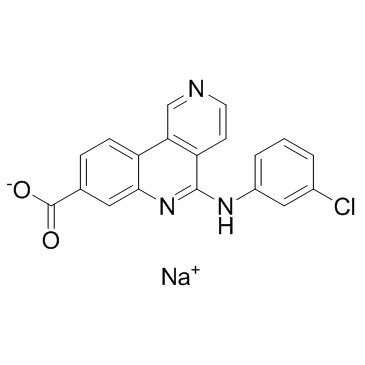| Cas No.: | 1309357-15-0 |
| Chemical Name: | Silmitasertib sodium |
| Synonyms: | CX-4945 (sodium salt);Silmitasertib sodium salt;sodium,5-(3-chloroanilino)benzo[c][2,6]naphthyridine-8-carboxylate |
| SMILES: | O=C(C1=CC=C2C3=C(C(NC4=CC=CC(Cl)=C4)=NC2=C1)C=CN=C3)[O-].[Na+] |
| Formula: | C19H11ClN3NaO2 |
| M.Wt: | 371.76 |
| Purity: | >98% |
| Sotrage: | 2 years -20°C Powder, 2 weeks 4°C in DMSO, 6 months -80°C in DMSO |
| Description: | CX-4945 sodium salt is an orally bioavailable, highly selective and potent CK2 inhibitor, with IC50 values of 1 nM against CK2α and CK2α'. |
| In Vivo: | CX-4945 (25 or 75 mg/kg, p.o.) is well tolerated and demonstrated robust antitumor activity with concomitant reductions of the mechanism-based biomarker phospho-p21 (T145) in murine xenograft models[1]. |
| In Vitro: | CX-4945 causes cell-cycle arrest and selectively induces apoptosis in cancer cells relative to normal cells, attenuates PI3K/Akt signalingand, and the antiproliferative activity of CX-4945 is correlated with expression levels of the CK2α catalytic subunit, Attenuation of PI3K/Akt signaling[1]. CX-4945 with bortezomib treatment prevents leukemic cells from engaging a functional UPR in order to buffer the bortezomib-mediated proteotoxic stress in ER lumen, and decreases pro-survival ER chaperon BIP/Grp78 expression[2]. CX-4945 induces cytotoxicity and apoptosis, and exerts anti-proliferative effects in hematological tumors by downregulating CK2 expression and suppressing activation of CK2-mediated PI3K/Akt/mTOR signaling pathways[3]. |
| Kinase Assay: | The percent inhibition of each kinase is estimated using 0.5 μM CX-4945 at ATP concentrations equivalent to the Km value for ATP for each respective human recombinant kinase. The determination of IC50 values is done at ATP concentrations equivalent to the Km for ATP for each kinase using 9 concentrations of CX-4945 over a range of 0.0001 to 1 μM. The Ki value (inhibition constant) for CX-4945 against recombinant CK2 is determined by graphing the IC50 values of CX-4945 determined in the presence of various concentrations of ATP against the concentration of ATP. |
| Cell Assay: | Various cell lines are seeded at a density of 3,000 cells per well 24 hours prior to treatment, in appropriate media, and then treated with indicated concentrations of CX-4945. Suspensions cells are seeded and treated on the same day. Following 4 days of incubation, Alamar Blue (20 μL, 10% of volume per well) is added and the cells are further incubated at 37°C for 4-5 hours. Fluorescence with excitation wavelength at 530-560 nm and emission wavelength at 590 nm is measured[1]. |
| Animal Administration: | Xenografts are initiated by subcutaneous injection of BxPC-3 cells into the right hind flank region of each mouse or BT-474 cells are injected into the mammary fat pad of mice implanted with estrogen pellets. When tumors reach a designated volume of 150-200 mm3, animals are randomized and divided into groups of 9 to 10 mice per group. CX-4945 is administered by oral gavage twice daily at 25 or 75 mg/kg for 31 and 35 consecutive days for the BT-474 and BxPC-3 models, respectively. Tumor volumes and body weights are measured twice weekly. The length and width of the tumor are measured with calipers and the volume calculated using the following formula: tumor volume=(length × width2)/2. |
| References: | [1]. Siddiqui-Jain A, et al. CX-4945, an orally bioavailable selective inhibitor of protein kinase CK2, inhibits prosurvival and angiogenic signaling and exhibits antitumor efficacy. Cancer Res. 2010 Dec 15;70(24):10288-98. [2]. Buontempo F, et al. Synergistic cytotoxic effects of bortezomib and CK2 inhibitor CX-4945 in acute lymphoblastic leukemia: turning off the prosurvival ER chaperone BIP/Grp78 and turning on the pro-apoptotic NF-κB. Oncotarget. 2016 Jan 12;7(2):1323-40. [3]. Chon HJ, et al. The casein kinase 2 inhibitor, CX-4945, as an anti-cancer drug in treatment of human hematological malignancies. Front Pharmacol. 2015 Mar 31;6:70. [4]. Kendall JJ, et al. CK2 blockade causes MPNST cell apoptosis and promotes degradation of β-catenin. Oncotarget. 2016 Aug 16;7(33):53191-53203 |

 DC Chemicals' products qualify for U.S. tariff exemptions. We guarantee no price increases due to customs duties and maintain stable supply, continuing to deliver reliable research solutions to our American clients.
DC Chemicals' products qualify for U.S. tariff exemptions. We guarantee no price increases due to customs duties and maintain stable supply, continuing to deliver reliable research solutions to our American clients.





















